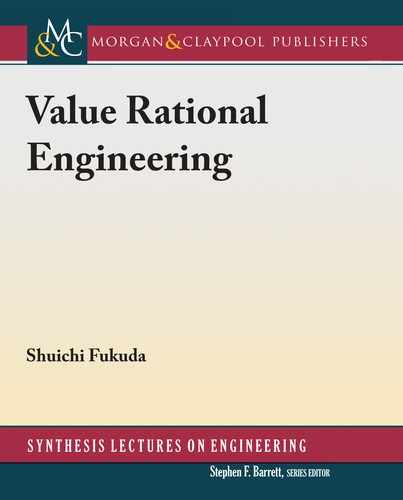
13
C H A P T E R 2
Value and Rationality:
Traditional Engineering
Definition
2.1 VALUE
e most well-known definition of value in engineering is the one defined by Lawrence D.
Miles [10]:
Value D Performance/Cost:
Although the numerator performance has broad meaning, it has long been interpreted as
functions. is is because people wanted products which were useful in their lives. And these
functions are defined by the producer, because what people wanted did not change from person
to person.
As the environments and situations did not change appreciably until recently, what people
needed was the same or very similar kinds of products. us, mass production became prevalent
and the producer took the initiative.
Note that cost is the denominator. In engineering, the quantitative approach is preferred.
So, if the numerator performance can be defined as functions, then we can evaluate cost in manu-
facturing quantitatively. us, in addition to upgrading and increasing functions, cost reduction
is called for to increase value. Value defined this way, therefore, can be evaluated quantitatively.
e rational approach permitted such quantitative evaluation. As Miles’ definition of value
is quantitative, it is also used widely in economics.
Rationality in our traditional engineering will be explained next.
2.2 RATIONALITY
SYSTEM IDENTIFICATION
Engineers prefer quantitative evaluation. But systems have a large number of degrees of free-
dom. So, as described in Chapter 1, engineers paid tremendous attention to reducing it to the
minimum. us, they succeeded in reducing the number of degrees of freedom and in classifying
them into system group categories.

14 2. VALUE AND RATIONALITY: TRADITIONAL ENGINEERING DEFINITION
us, what engineers needed was to identify which group category the system belongs to
(System Identification). en, they will know what parameters they must take care of. ere-
fore, functions and cost can be evaluated quantitatively and such rationality is mathematical
rationality.
BOUNDED RATIONALITY AND SATISFICING
But Herbert Simon, Nobel Laurate in economics, pointed out that such rationality is
bounded [1]. Increasing size and complexity of the system causes computational complexity
and we cannot apply mathematical rational approaches. He pointed out that optimization is
possible only when mathematical rationality can be applied. Beyond the bounds of rationality,
we have no other choice than to settle for satisfaction. So, he proposed Satisficing (Satisfy C
Suffice) [2].
INDIVIDUAL PRODUCTS
Why value can be evaluated quantitatively, and optimum result (value) can be obtained in tradi-
tional engineering, is because engineers used to work on individual products. e systems they
worked on are not too large or complex. erefore, they can reduce the number of degrees of
freedom and solve the problem along the line of mathematical rationality.
GLOBAL OPTIMIZATION—ANOTHER SATISFICING
We must remember that even in the field of optimization, when it comes to global optimiza-
tion, we are not really optimizing mathematically. What we do is nothing other than satisficing
(Fig. 2.1)
SA Simulated Annealing
Global Optimization
Fluctuations
Figure 2.1: Global optimization.
For example, simulated annealing repeats searches many times. So, we believe the highest
one we find after many searches is the highest (optimum). But, the higher peak might come up
in the next search.
2.2. RATIONALITY 15
Since it only satisfies us by doing so many searches, global optimization is none other than
satisficing.
..................Content has been hidden....................
You can't read the all page of ebook, please click here login for view all page.
